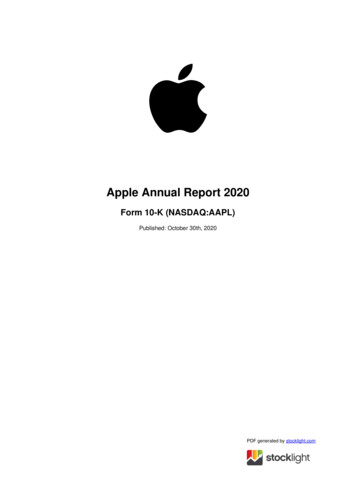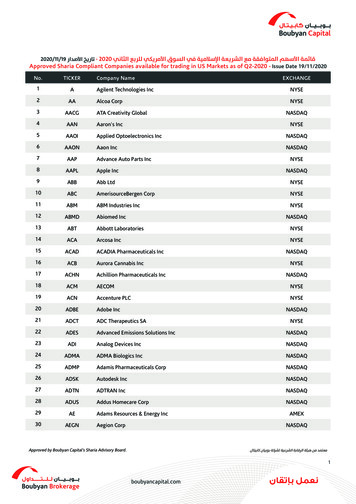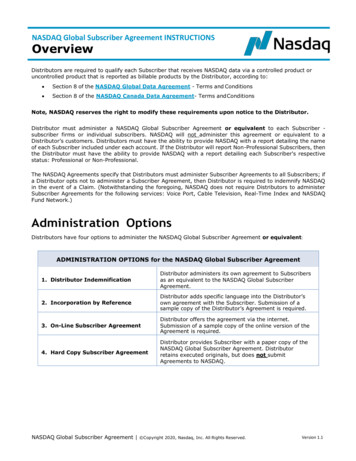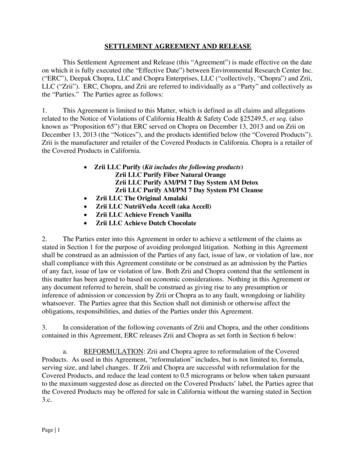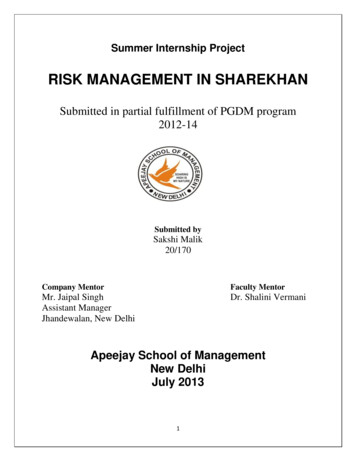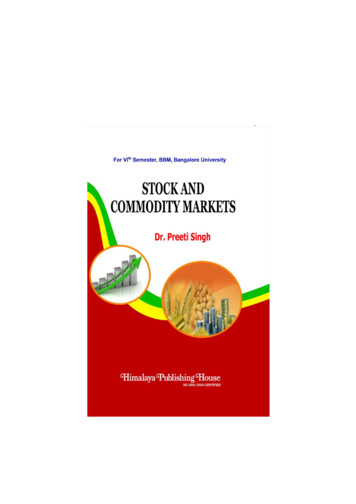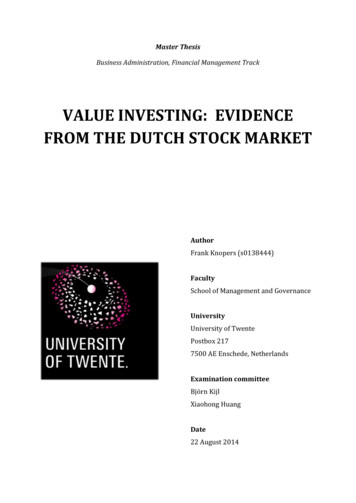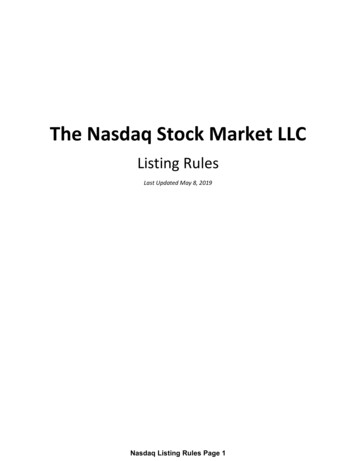
Transcription
The Nasdaq Stock Market LLCListing RulesLast Updated May 8, 2019Nasdaq Listing Rules Page 1
Nasdaq Stock Market Rules, Regulation, Nasdaq, 5001. The Qualification,Listing, and Delisting of CompaniesClick to open document in a browserThis Rule Series 5000 (consisting of Rules 5000-5999) contains rules related to the qualification, listing anddelisting of Companies on The Nasdaq Stock Market.The Rule 5100 Series (consisting of Rules 5100-5199) discusses Nasdaq's general regulatory authority. TheRule 5200 Series (consisting of Rules 5200-5299) sets forth the procedures and prerequisites for gaining alisting on The Nasdaq Stock Market, as well as the disclosure obligations of listed Companies. The Rule 5300,5400, and 5500 Series (consisting of Rules 5300-5399, 5400-5499, and 5500-5599, respectively) contain thespecific the quantitative listing requirements for listing on the Global Select, Global Market, and Capital Market,respectively. The corporate governance requirements applicable to all Companies are contained in the Rule5600 Series (consisting of Rules 5600-5699). Special listing requirements for securities other than common orpreferred stock and warrants are contained in the Rule 5700 Series (consisting of Rules 5700- 5799). Theconsequences of a failure to meet Nasdaq's listing standards are contained in the Rule 5800 Series (consistingof Rules 5800-5899). Finally, Company listing fees are described in the Rule 5900 Series (consisting of Rules5900-5999).Nasdaq exercises other authorities important to listed Companies discussed in other Rules Series in theMarketplace Rules. For example, Nasdaq may close markets upon request of the SEC (see Rule 4121). It mayalso halt the trading of a Company's securities under certain circumstances and pursuant to establishedprocedures (See Rule 4120 and IM-5250-1 and IM-5810). These authorities are exercised primarily by theMarketWatch Department and are contained in the Rule 4000 series.Nasdaq and Financial Industry Regulatory Authority, Inc. ( "FINRA") are parties to a regulatory contract pursuantto which FINRA has agreed to perform certain functions described in the Rules on behalf of Nasdaq.Notwithstanding the fact that Nasdaq has entered into the regulatory contract with FINRA to perform some ofNasdaq's functions, Nasdaq shall retain ultimate legal responsibility for, and control of, such functions.Amended by SR-NASDAQ-2009-052 eff. June 16, 2009; amended Oct. 18, 2017 (SR-NASDAQ-2017-111).Copyright 2018, The Nasdaq OMX Group, Inc. All Rights Reserved.The Nasdaq Manual is reproduced by permission of The Nasdaq OMX Group, Inc. ("Nasdaq OMX") under anon-exclusive license. Nasdaq OMX accepts no responsibility for the accuracy or otherwise of the reproductionof the NASDAQ Manual in the CCH Securities Compliance Library. Any advice or commentary given in the CCHSecurities Compliance Library about the Nasdaq Manual is the sole responsibility of Wolters Kluwer FinancialServices and does not reflect the views of Nasdaq OMX. Nasdaq OMX reserves the right to amend the NasdaqManual at its discretion. 2019 Wolters Kluwer Financial Services, Inc. All rights reserved.Subject to Terms & Conditions: http://researchhelp.cch.com/License Agreement.htm389Nasdaq Listing Rules Page 2
Nasdaq Stock Market Rules, Regulation, 5005., Nasdaq, DefinitionsClick to open document in a browser(a) The following is a list of definitions used throughout the Nasdaq Listing Rules. This section also listsvarious terms together with references to other rules where they are specifically defined. Unless otherwisespecified by the Rules, these terms shall have the meanings set forth below. Defined terms are capitalizedthroughout the Listing Rules.(1) "Act" means the Securities Exchange Act of 1934.(2) "Best efforts offering" means an offering of securities by members of a selling group under anagreement that imposes no financial commitment on the members of such group to purchase any suchsecurities except as they may elect to do so.(3) "Bid Price" means the closing bid price.(4) "Cash flows", as it pertains to The Nasdaq Global Select Market, is defined in the Rule 5310(b).(5) "Commission" or "SEC" means the United States Securities and Exchange Commission.(6) "Company" means the issuer of a security listed or applying to list on Nasdaq. For purposes of theRule 5000 Series, the term "Company" includes an issuer that is not incorporated, such as, for example, alimited partnership.(7) "Consolidated Quotation Service" (CQS) means the consolidated quotation collection system forsecurities listed on an exchange other than Nasdaq implementing Rule 602 of Regulation NMS under theAct.(8) "Country of Domicile" means the country under whose laws a Company is organized or incorporated.(9) "Covered Security" means a security described in Section 18(b) of the Securities Act of 1933.(10) "Direct Registration Program" means any program by a Company, directly or through its transferagent, whereby a Shareholder may have securities registered in the Shareholder's name on the books ofthe Company or its transfer agent without the need for a physical certificate to evidence ownership.(11) "Dually-Listed Security" means a security, listed on The Nasdaq Global Market or The NasdaqGlobal Select Market, which is also listed on the New York Stock Exchange.(12) "EDGAR System" means the SEC's Electronic Data Gathering, Analysis, and Retrieval system.(13) “Equity Investment Tracking Stock” means a class of common equity securities that tracks on anunleveraged basis the performance of an investment by the issuer in the common equity securities of asingle other company listed on Nasdaq. An Equity Investment Tracking Stock may track multiple classesof common equity securities of a single issuer, so long as all of those classes have identical economicrights and at least one of those classes is listed on Nasdaq.(14) "ESOP" means employee stock option plan.(15) "Executive Officer" is defined in Rule 5605(a)(1).(16) "Filed with Nasdaq" means submitted to Nasdaq directly or filed with the Commission through theEDGAR System.(17) "Firm Commitment Offering" means an offering of securities by participants in a selling syndicateunder an agreement that imposes a financial commitment on participants in such syndicate to purchase 2019 Wolters Kluwer Financial Services, Inc. All rights reserved.Subject to Terms & Conditions: http://researchhelp.cch.com/License Agreement.htm390Nasdaq Listing Rules Page 3
such securities.(18) "Family Member" is defined in Rule 5605(a)(2).(19) "Foreign Private Issuer" shall have the same meaning as under Rule 3b-4 under the Act.(20) "Independent Director" is defined in Rule 5605(a)(2).(21) "Index Warrants" is defined in Rule 5725(a).(22) "Listed Securities" means securities listed on Nasdaq or another national securities exchange.(23) "Market Value" means the consolidated closing bid price multiplied by the measure to be valued(e.g., a Company's Market Value of Publicly Held Shares is equal to the consolidated closing bid pricemultiplied by a Company's Publicly Held Shares).(24) "Member" means a broker or dealer admitted to membership in Nasdaq.(25) "Market Maker" means a dealer that, with respect to a security, holds itself out (by enteringquotations in the Nasdaq Market Center) as being willing to buy and sell such security for its own accounton a regular and continuous basis and that is registered as such.(26) "The Nasdaq Global Market" or "Global Market" or "NGM" is a distinct tier of Nasdaq comprised oftwo segments: The Nasdaq Global Market and The Nasdaq Global Select Market. The Nasdaq GlobalMarket is the successor to the Nasdaq National Market.(27) "Nasdaq Global Market security" or "NGM security" means any security listed on Nasdaq that (1)satisfies all applicable requirements of the Rule 5100 and 5200 Series and meets the criteria set forth inthe Rule 5400 Series; (2) is a right to purchase such security; (3) is a warrant to subscribe to suchsecurity; or (4) is an Index Warrant which meets the criteria set forth in Rule 5725(a).(28) "The Nasdaq Capital Market" or "Capital Market" is a distinct tier of Nasdaq comprised of securitiesthat meet the requirements of the Rule 5100, 5200 and 5500 Series, and are listed as Nasdaq CapitalMarket securities. The Nasdaq Capital Market is the successor to The Nasdaq SmallCap Market.(29) "Nasdaq Capital Market security" means any security listed on The Nasdaq Capital Market that (1)satisfies all applicable requirements of the Rule 5100, 5200 and 5500 Series but that is not a NasdaqGlobal Market security; (2) is a right to purchase such security; or (3) is a warrant to subscribe to suchsecurity.(30) "The Nasdaq Global Select Market" or "Global Select Market" or "Global Select" or "NGSM" is asegment of The Nasdaq Global Market comprised of NGM securities that met the requirements for initialinclusion contained in the Rule 5100, 5200 and 5300 Series.(31) "Nasdaq Global Select Market security" or "NGSM security" means any security listed on Nasdaqand included in The Nasdaq Global Select segment of The Nasdaq Global Market.(32) "Other Regulatory Authority" means: (i) in the case of a bank or savings authority identified inSection 12(i) of the Act, the agency vested with authority to enforce the provisions of Section 12 of theAct; or (ii) in the case of an insurance company that is subject to an exemption issued by the Commissionthat permits the listing of the security, notwithstanding its failure to be registered pursuant to section 12(b),the Commissioner of Insurance (or other officer or agency performing a similar function) of its domiciliarystate.(33) "Primary Equity Security" means a Company's first class of Common Stock, Ordinary Shares,Shares or Certificates of Beneficial Interest of Trust, Limited Partnership Interests or American DepositaryReceipts (ADR) or Shares (ADS). 2019 Wolters Kluwer Financial Services, Inc. All rights reserved.Subject to Terms & Conditions: http://researchhelp.cch.com/License Agreement.htm391Nasdaq Listing Rules Page 4
(34) "Private Placement Market" is a trading system for unregistered securities operated by a nationalsecurities exchange or a registered broker-dealer.(35) "Publicly Held Shares" means shares not held directly or indirectly by an officer, director or anyperson who is the beneficial owner of more than 10 percent of the total shares outstanding.Determinations of beneficial ownership in calculating publicly held shares shall be made in accordancewith Rule 13d-3 under the Act.(36) "Public Holders" means holders of a security that includes both beneficial holders and holders ofrecord, but does not include any holder who is, either directly or indirectly, an Executive Officer, director,or the beneficial holder of more than 10% of the total shares outstanding.(37) "Reverse Merger" means any transaction whereby an operating company becomes an ExchangeAct reporting company by combining, either directly or indirectly, with a shell company which is anExchange Act reporting company, whether through a reverse merger, exchange offer, or otherwise.However, a Reverse Merger does not include the acquisition of an operating company by a listedcompany satisfying the requirements of IM-5101-2 or a business combination described in Rule 5110(a).In determining whether a Company is a shell company, Nasdaq will look to a number of factors, includingbut not limited to: whether the Company is considered a “shell company” as defined in Rule 12b-2 underthe Act; what percentage of the Company’s assets are active versus passive; whether the Companygenerates revenues, and if so, whether the revenues are passively or actively generated; whether theCompany’s expenses are reasonably related to the revenues being generated; how many employeessupport the Company’s revenue-generating business operations; how long the Company has beenwithout material business operations; and whether the Company has publicly announced a plan to beginoperating activities or generate revenues, including through a near-term acquisition or transaction.(38) "Round Lot" or "Normal Unit of Trading" means 100 shares of a security unless, with respect to aparticular security, Nasdaq determines that a normal unit of trading shall constitute other than 100 shares.If a normal unit of trading is other than 100 shares, a special identifier shall be appended to theCompany's Nasdaq symbol.(39) "Round Lot Holder" means a holder of a Normal Unit of Trading. The number of beneficial holderswill be considered in addition to holders of record.(40) "Shareholder" means a record or beneficial owner of a security listed or applying to list. Forpurposes of the Rule 5000 Series, the term "Shareholder" includes, for example, a limited partner, theowner of a depository receipt, or unit.(41) "Substantial Shareholder" is defined in Rule 5635(e)(3).(42) "Substitution Listing Event" means: a reverse stock split, re-incorporation or a change in theCompany's place of organization, the formation of a holding company that replaces a listed Company,reclassification or exchange of a Company's listed shares for another security, the listing of a new class ofsecurities in substitution for a previously-listed class of securities, a business combination described in IM5101-2, a change in the obligor of a listed debt security, or any technical change whereby theShareholders of the original Company receive a share-for-share interest in the new Company without anychange in their equity position or rights. A Substitution Listing Event also includes the replacement of, orany significant modification to, the index, portfolio or Reference Asset underlying a security listed underthe Rule 5700 Series (including, but not limited to, a significant modification to the index methodology, achange in the index provider, or a change in control of the index provider).(43) "Total Holders" means holders of a security that includes both beneficial holders and holders ofrecord.Adopted Mar. 12, 2009 (SR-NASDAQ-2009-018); amended Apr. 27, 2009 ( SR-NASDAQ-2009-040); amended June 16, 2009 (SR- 2019 Wolters Kluwer Financial Services, Inc. All rights reserved.Subject to Terms & Conditions: http://researchhelp.cch.com/License Agreement.htm392Nasdaq Listing Rules Page 5
NASDAQ-2009-052); amended Nov. 8, 2011 (SR-NASDAQ-2011-073); amended Oct. 2, 2013 (SR-NASDAQ-2013-130); amendedApr. 20, 2016 (SR-NASDAQ-2016-059); amended June 8, 2017 (SR-NASDAQ-2017-058), operative July 8, 2017; amended Nov. 13,2018 (SR-NASDAQ-2018-070); amended Feb. 13, 2019 (SR-NASDAQ-2019-001).Copyright 2018, The Nasdaq OMX Group, Inc. All Rights Reserved.The Nasdaq Manual is reproduced by permission of The Nasdaq OMX Group, Inc. ("Nasdaq OMX") under anon-exclusive license. Nasdaq OMX accepts no responsibility for the accuracy or otherwise of the reproductionof the NASDAQ Manual in the CCH Securities Compliance Library. Any advice or commentary given in the CCHSecurities Compliance Library about the Nasdaq Manual is the sole responsibility of Wolters Kluwer FinancialServices and does not reflect the views of Nasdaq OMX. Nasdaq OMX reserves the right to amend the NasdaqManual at its discretion. 2019 Wolters Kluwer Financial Services, Inc. All rights reserved.Subject to Terms & Conditions: http://researchhelp.cch.com/License Agreement.htm393Nasdaq Listing Rules Page 6
Nasdaq Stock Market Rules, Regulation, 5101., Nasdaq, Preamble to theRule 5100 SeriesClick to open document in a browserNasdaq is entrusted with the authority to preserve and strengthen the quality of and public confidence in itsmarket. Nasdaq stands for integrity and ethical business practices in order to enhance investor confidence,thereby contributing to the financial health of the economy and supporting the capital formation process. NasdaqCompanies, from new public Companies to Companies of international stature, are publicly recognized assharing these important objectives.Nasdaq, therefore, in addition to applying the enumerated criteria set forth in the Rule 5000 Series, has broaddiscretionary authority over the initial and continued listing of securities in Nasdaq in order to maintain the qualityof and public confidence in its market, to prevent fraudulent and manipulative acts and practices, to promote justand equitable principles of trade, and to protect investors and the public interest. Nasdaq may use suchdiscretion to deny initial listing, apply additional or more stringent criteria for the initial or continued listing ofparticular securities, or suspend or delist particular securities based on any event, condition, or circumstancethat exists or occurs that makes initial or continued listing of the securities on Nasdaq inadvisable orunwarranted in the opinion of Nasdaq, even though the securities meet all enumerated criteria for initial orcontinued listing on Nasdaq. In all circumstances where the Listing Qualifications Department (as defined in Rule5805) exercises its authority under Rule 5101, the Listing Qualifications Department shall issue a Staff DelistingDetermination under Rule 5810(c)(1), and in all circumstances where an Adjudicatory Body (as defined in Rule5805) exercises such authority, the use of the authority shall be described in the written decision of theAdjudicatory Body.Amended June 16, 2009 (SR-NASDAQ-2009-052).Copyright 2018, The Nasdaq OMX Group, Inc. All Rights Reserved.The Nasdaq Manual is reproduced by permission of The Nasdaq OMX Group, Inc. ("Nasdaq OMX") under anon-exclusive license. Nasdaq OMX accepts no responsibility for the accuracy or otherwise of the reproductionof the NASDAQ Manual in the CCH Securities Compliance Library. Any advice or commentary given in the CCHSecurities Compliance Library about the Nasdaq Manual is the sole responsibility of Wolters Kluwer FinancialServices and does not reflect the views of Nasdaq OMX. Nasdaq OMX reserves the right to amend the NasdaqManual at its discretion. 2019 Wolters Kluwer Financial Services, Inc. All rights reserved.Subject to Terms & Conditions: http://researchhelp.cch.com/License Agreement.htm394Nasdaq Listing Rules Page 7
Nasdaq Stock Market Rules, Regulation, IM-5101-1., Nasdaq, Use ofDiscretionary AuthorityClick to open document in a browserTo further Companies' understanding of Rule 5101, Nasdaq has adopted this Interpretive Material as a nonexclusive description of the circumstances in which the Rule is generally invoked.Nasdaq may use its authority under Rule 5101 to deny initial or continued listing to a Company when anindividual with a history of regulatory misconduct is associated with the Company. Such individuals are typicallyan officer, director, Substantial Shareholder (as defined in Rule 5635(e)(3)), or consultant to the Company. Inmaking this determination, Nasdaq will consider a variety of factors, including: the nature and severity of the conduct, taken in conjunction with the length of time since the conduct occurred; whether the conduct involved fraud or dishonesty; whether the conduct was securities-related; whether the investing public was involved; how the individual has been employed since the violative conduct; whether there are continuing sanctions (either criminal or civil) against the individual; whether the individual made restitution; whether the Company has taken effective remedial action; and the totality of the individual's relationship to the Company, giving consideration to: the individual's current or proposed position; the individual's current or proposed scope of authority; the extent to which the individual has responsibility for financial accounting or reporting; and the individual's equity interest.Based on this review, Nasdaq may determine that the regulatory history rises to the level of a public interestconcern, but may also consider whether remedial measures proposed by the Company, if taken, would allay thatconcern. Examples of such remedial measures could include any or all of the following, as appropriate: the individual's resignation from officer and director positions, and/or other employment with the Company; divestiture of stock holdings; terminations of contractual arrangements between the Company and the individual; or the establishment of a voting trust surrounding the individual's shares.Nasdaq staff is willing to discuss with Companies, on a case-by-case basis, what remedial measures may beappropriate to address public interest concerns, and for how long such remedial measures would be required.Alternatively, Nasdaq may conclude that a public interest concern is so serious that no remedial measure wouldbe sufficient to alleviate it. In the event that Nasdaq staff denies initial or continued listing based on such publicinterest considerations, the Company may seek review of that determination through the procedures set forth inthe Rule 5800 Series. On consideration of such appeal, a listing qualifications panel comprised of personsindependent of Nasdaq may accept, reject or modify the staff's recommendations by imposing conditions.Nasdaq may also use its discretionary authority, for example, when a Company files for protection under anyprovision of the federal bankruptcy laws or comparable foreign laws, when a Company's independentaccountants issue a disclaimer opinion on financial statements required to be audited, or when financialstatements do not contain a required certification.In addition, pursuant to its discretionary authority, Nasdaq will review the Company's past corporate governanceactivities. This review may include activities taking place while the Company is listed on Nasdaq or an exchange 2019 Wolters Kluwer Financial Services, Inc. All rights reserved.Subject to Terms & Conditions: http://researchhelp.cch.com/License Agreement.htm395Nasdaq Listing Rules Page 8
that imposes corporate governance requirements, as well as activities taking place after a formerly listedcompany is no longer listed on Nasdaq or such an exchange. Based on such review, and in accordance with theRule 5800 Series, Nasdaq may take any appropriate action, including placing restrictions on or additionalrequirements for listing, or denying listing of a security, if Nasdaq determines that there have been violations orevasions of such corporate governance standards. Such determinations will be made on a case-by-case basisas necessary to protect investors and the public interest.Although Nasdaq has broad discretion under Rule 5101 to impose additional or more stringent criteria, the Ruledoes not provide a basis for Nasdaq to grant exemptions or exceptions from the enumerated criteria for initial orcontinued listing, which may be granted solely pursuant to rules explicitly providing such authority.Adopted March 12, 2009 (SR-NASDAQ-2009-018); amended June 16, 2009 (SR-NASDAQ-2009-052).Copyright 2018, The Nasdaq OMX Group, Inc. All Rights Reserved.The Nasdaq Manual is reproduced by permission of The Nasdaq OMX Group, Inc. ("Nasdaq OMX") under anon-exclusive license. Nasdaq OMX accepts no responsibility for the accuracy or otherwise of the reproductionof the NASDAQ Manual in the CCH Securities Compliance Library. Any advice or commentary given in the CCHSecurities Compliance Library about the Nasdaq Manual is the sole responsibility of Wolters Kluwer FinancialServices and does not reflect the views of Nasdaq OMX. Nasdaq OMX reserves the right to amend the NasdaqManual at its discretion. 2019 Wolters Kluwer Financial Services, Inc. All rights reserved.Subject to Terms & Conditions: http://researchhelp.cch.com/License Agreement.htm396Nasdaq Listing Rules Page 9
Nasdaq Stock Market Rules, Regulation, IM-5101-2., Nasdaq, Listing ofCompanies Whose Business Plan is to Complete One or MoreAcquisitionsClick to open document in a browserGenerally, Nasdaq will not permit the initial or continued listing of a Company that has no specific business planor that has indicated that its business plan is to engage in a merger or acquisition with an unidentified companyor companies.However, in the case of a Company whose business plan is to complete an initial public offering and engage in amerger or acquisition with one or more unidentified companies within a specific period of time, Nasdaq willpermit the listing if the Company meets all applicable initial listing requirements, as well as the conditionsdescribed below.(a) At least 90% of the gross proceeds from the initial public offering and any concurrent sale by thecompany of equity securities must be deposited in a trust account maintained by an independent trustee, anescrow account maintained by an "insured depository institution," as that term is defined in Section 3(c)(2) ofthe Federal Deposit Insurance Act or in a separate bank account established by a registered broker or dealer(collectively, a "deposit account").(b) Within 36 months of the effectiveness of its IPO registration statement, or such shorter period that thecompany specifies in its registration statement, the Company must complete one or more businesscombinations having an aggregate fair market value of at least 80% of the value of the deposit account(excluding any deferred underwriters fees and taxes payable on the income earned on the deposit account)at the time of the agreement to enter into the initial combination.(c) Until the Company has satisfied the condition in paragraph (b) above, each business combination mustbe approved by a majority of the Company's Independent Directors.(d) Until the Company has satisfied the condition in paragraph (b) above, if the Company holds ashareholder vote on a business combination for which the Company must file and furnish a proxy orinformation statement subject to Regulation 14A or 14C under the Act in advance of the shareholder meeting,the business combination must be approved by a majority of the shares of common stock voting at themeeting at which the combination is being considered. If a shareholder vote on the business combination isheld, public Shareholders voting against a business combination must have the right to convert their sharesof common stock into a pro rata share of the aggregate amount then in the deposit account (net of taxespayable and amounts distributed to management for working capital purposes) if the business combination isapproved and consummated. A Company may establish a limit (set no lower than 10% of the shares sold inthe IPO) as to the maximum number of shares with respect to which any Shareholder, together with anyaffiliate of such Shareholder or any person with whom such shareholder is acting as a "group" (as such termis used in Sections 13(d) and 14(d) of the Act), may exercise such conversion rights. For purposes of thisparagraph (d), public Shareholder excludes officers and directors of the Company, the Company’s sponsor,the founding Shareholders of the Company, and any Family Member or affiliate of any of the foregoingpersons, or the beneficial holder of more than 10% of the total shares outstanding.Until the Company completes a business combination where all conditions in paragraph (b) above are met,the Company must notify Nasdaq on the appropriate form about each proposed business combination.Following each business combination, the combined Company must meet the requirements for initial listing. Ifthe Company does not meet the requirements for initial listing following a business combination or does notcomply with one of the requirements set forth above, Nasdaq will issue a Staff Delisting Determination underRule 5810 to delist the Company's securities.(e) Until the Company has satisfied the condition in paragraph (b) above, if a shareholder vote on the 2019 Wolters Kluwer Financial Services, Inc. All rights reserved.Subject to Terms & Conditions: http://researchhelp.cch.com/License Agreement.htm397Nasdaq Listing Rules Page 10
business combination is not held for which the Company must file and furnish a proxy or informationstatement subject to Regulation 14A or 14C under the Act, the Company must provide all Shareholders withthe opportunity to redeem all their shares for cash equal to their pro rata share of the aggregate amount thenin the deposit account (net of taxes payable and amounts distributed to management for working capitalpurposes), pursuant to Rule 13e-4 and Regulation 14E under the Act, which regulate issuer tender offers.The Company must file tender offer documents with the Commission containing substantially the samefinancial and other information about the business combination and the redemption rights as would berequired under Regulation 14A of the Act, which regulates the solicitation of proxies.Until the Company completes a business combination where all conditions in paragraph (b) above are met,the Company must notify Nasdaq on the appropriate form about each proposed business combination.Following each business combination, the combined Company must meet the requirements for initial listing. Ifthe Company does not meet the requirements for initial listing following a business combination or does notcomply with one of the requirements set forth above, Nasdaq will issue a Staff Delisting Determination underRule 5810 to delist the Company’s securities.Adopted March 12, 2009 (SR-NASDAQ-2009-018); amended June 16, 2009 (SR-NASDAQ-2009-052); amended Dec. 23, 2010 (SRNASDAQ-2010-137).Copyright 2018, The Nasdaq OMX Group, Inc. All Rights Reserved.The Nasdaq Manual is reproduced by permission of The Nasdaq OMX Group, Inc. ("Nasdaq OMX") under anon-exclusive license. Nasdaq OMX accepts no responsibility for the accuracy or otherwise of the reproductionof the NASDAQ Manual in the CCH Securities Compliance Library. Any advice or commentary given in the CCHSecurities Compliance Library about the Nasdaq Manual is the sole responsibility of Wolters Kluwer FinancialServices and does not reflect the views of Nasdaq OMX. Nasdaq OMX reserves the right to amend
Nasdaq Stock Market Rules, Regulation, Nasdaq, 5001. The Qualification, Listing, and Delisting of Companies. Click to open document in a browser This Rule Series 5000 (consisting of Rules 5000-5999) contains rules related to the qualification, listing and delisting

